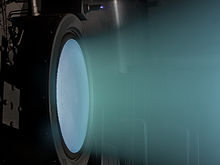NEXT (ion thruster)

The NASA Evolutionary Xenon Thruster (NEXT) project at Glenn Research Center is a gridded electrostatic ion thruster about three times as powerful as the NSTAR used on Dawn and Deep Space 1 spacecraft.[1][2] It was used in DART, launched in 2021.
Glenn Research Center manufactured the test engine's core ionization chamber, and Aerojet Rocketdyne designed and built the ion acceleration assembly.[3][4]
Purpose and objectives
[edit]NEXT affords larger delivered payloads, smaller launch vehicle size, and other mission enhancements compared to chemical and other electric propulsion technologies for Discovery, New Frontiers, Mars Exploration, and Flagship outer-planet exploration missions.[2]
Design and Performance
[edit]The NEXT engine is a type of solar electric propulsion in which thruster systems use the electricity generated by the spacecraft's solar panel to accelerate the xenon propellant to speeds of up to 90,000 mph (145,000 km/h or 40 km/s).[3] NEXT can consume 6.9 kW power to produce 237 mN thrust, with a specific impulse of 4,170 seconds (compared to 3120 for NSTAR),[2] and has been run for over five years.[5] It can be throttled down to 0.5 kW power, when it has a specific impulse of 1320 seconds.[2]
Longevity and total impulse
[edit]The NEXT thruster has demonstrated, in ground tests, a total impulse of 17 MN·s; which as of 2010 was the highest total impulse ever demonstrated by an ion thruster.[2] A beam extraction area 1.6 times that of NSTAR allows higher thruster input power while maintaining low voltages and ion current densities, thus maintaining thruster longevity.[2]
In November 2010, it was revealed that the prototype had completed a 48,000 hours (5.5 years) test in December 2009.[3][5][6] Thruster performance characteristics, measured over the entire throttle range of the thruster, were within predictions and the engine showed little signs of degradation and is ready for mission opportunities.[2]
Development and Status
[edit]NEXT completed its System Requirement Review in July 2015 and Preliminary Design Review in February 2016. The first two flight units will be available in early 2019.[7] After 2019, it will be a commercial product for purchase by NASA and non-NASA customers.[7] Aerojet Rocketdyne, and their major sub-contractor ZIN Technologies retain the rights to produce the system, known as NEXT-C for future commercialization.[7]
In 2018, the CAESAR mission concept to comet 67P/Churyumov–Gerasimenko was a finalist for the New Frontiers program mission #4, and if selected, it would have been propelled by the NEXT ion engine.[8] However, on 27 June 2019, the other finalist, the Dragonfly mission, was chosen instead.[9]
NEXT-C was selected[when?] for the DART mission.
Use in space
[edit]Launched in November 2021, for the first time in space, the Double Asteroid Redirection Test (DART) spacecraft used the NEXT-C ion thruster[10][11][12] powered by 22 m2 of solar arrays generating ~3.5 kW.[13]
See also
[edit]- Electrically powered spacecraft propulsion
- Hall effect thruster, a different type of ion thruster
- Advanced Electric Propulsion System – Spacecraft propulsion system by NASA. 50kW Hall-effect thrusters, now for Lunar Gateway
- Nuclear electric rocket
References
[edit]- ^ George R Schmidt; Michael J Patterson; Scott W Benson. "The NASA Evolutionary Xenon Thruster (NEXT): the next step for US deep space propulsion" (PDF). Archived from the original (PDF) on 2010-05-18.
- ^ a b c d e f g Herman, Daniel A. (May 3–7, 2010), "NASA's Evolutionary Xenon Thruster (NEXT) Project Qualification Propellant Throughput Milestone: Performance, Erosion, and Thruster Service Life Prediction After 450 kg" (PDF), 57th Joint Army-Navy-NASA-Air Force (JANNAF) Propulsion Meeting, Colorado Springs, Colorado, USA: NASA - Glenn Research Center, retrieved 2014-03-08
- ^ a b c Dwayne Brown; Katherine K. Martin; Glenn Mahone. "NASA Thruster Achieves World-Record 5+ Years of Operation". Retrieved 2013-06-24.
- ^ NASA Thruster Achieves World-Record 5+Years of Operation. NASA. June 24, 2013.
- ^ a b David Szondy. "NASA's NEXT ion thruster runs five and a half years nonstop to set new record". Retrieved 26 June 2013.
- ^ Nancy Smith Kilkenny, SGT, Inc. "NEXT Provides Lasting Propulsion and High Speeds for Deep Space Missions". Retrieved 29 September 2013.
{{cite web}}: CS1 maint: multiple names: authors list (link) - ^ a b c Dolloff, M.; Jackson, J. (March 2016). Current Status of NASA Evolutionary Xenon Thruster - Commercial (NEXT-C) (PDF). 47th Lunar and Planetary Science Conference.
- ^ "CAESAR Project Overview" (PDF). Lunar and Planetary Institute. 17 January 2018. Retrieved 2018-01-19.
- ^ Brown, David (27 June 2019). "NASA Announces New Dragonfly Drone Mission to Explore Titan". The New York Times. Retrieved 27 June 2019.
- ^ Planetary Defense: Double Asteroid Redirection Test (DART) Mission NASA 2017
 This article incorporates text from this source, which is in the public domain.
This article incorporates text from this source, which is in the public domain.
- ^ Kantsiper, Brian (2017). "The Double Asteroid Redirection Test (DART) mission electric propulsion trade". 2017 IEEE Aerospace Conference. pp. 1–7. doi:10.1109/AERO.2017.7943736. ISBN 978-1-5090-1613-6. S2CID 43072949.
- ^ Herridge, Linda (24 November 2021). "NASA, SpaceX Launch DART: First Planetary Defense Test Mission". nasa.gov. NASA. Retrieved 26 November 2021.
- ^ Adams, Elena; Oshaughnessy, Daniel; Reinhart, Matthew; John, Jeremy; Congdon, Elizabeth; Gallagher, Daniel; Abel, Elisabeth; Atchison, Justin; Fletcher, Zachary; Chen, Michelle; Heistand, Christopher; Huang, Philip; Smith, Evan; Sibol, Deane; Bekker, Dmitriy; Carrelli, David (2019). "Double Asteroid Redirection Test: The Earth Strikes Back". 2019 IEEE Aerospace Conference. pp. 1–11. doi:10.1109/AERO.2019.8742007. ISBN 978-1-5386-6854-2. S2CID 195222414.
